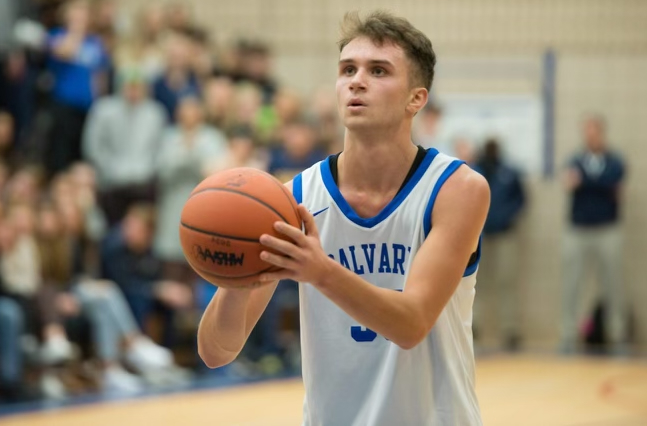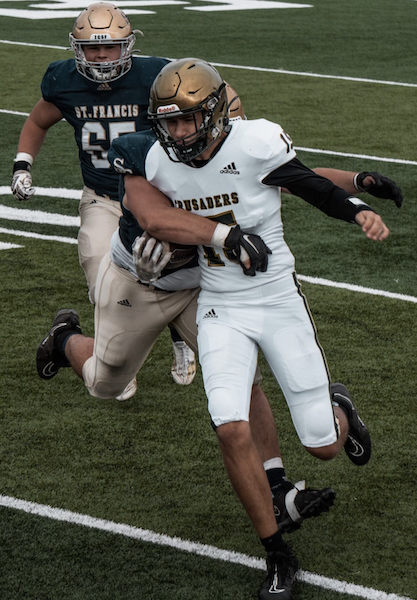
Track Gaining Speed Toward Future with Electronic Starting Devices
By
Steve Vedder
Special for MHSAA.com
May 23, 2023
Aubrey Greenfield thinks it might be the perfect time to reevaluate 130 years of tradition.
For a number of reasons, from technical to personal, the Oxford senior sprinter believes it makes sense for the crack of a starting pistol to be eliminated from high school track meets.
Because track meets would benefit in various ways from lowering costs to easier setup at meets to the human factor of competitors not having to flinch at the crack of a pistol shot, Greenfield believes the sport has a chance to embrace new technology – electronic starting devices (ESD).
In essence, an ESD replaces the starting pistol with a light flash, tone sound or both to begin a race.
"High school sports should put the athlete first," Greenfield said. "We should promote sports, and eliminating starting pistols promotes health in terms of PTSD or trauma for athletes and spectators and that would be good. I would like to think people would say that's a good idea."
In fact, Greenfield would go as far as to say if there was not an implementation of electronic starting devices, many of her teammates would have considered giving up the sport.
"If it's something that helps us compete safely, we're all for it," she said.
Greenfield's opinion apparently is spreading. Michigan High School Athletic Association senior assistant director Cody Inglis said the use of ESD makes it both affordable for meet starters and sensible for athletes and fans to rethink the use of starting pistols. While the MHSAA is not mandating electronic starting devices, it does promote the use of what Inglis calls "emerging technology." He notes that ESD are becoming the norm for organizations such as USA Track & Field, the NCAA and an increasing number of high schools.
 "I think we have to embrace new technology, and we think this will be something that takes hold," Inglis said.
"I think we have to embrace new technology, and we think this will be something that takes hold," Inglis said.
A key part of embracing ESD is the human element. The tragic Oxford High School shooting Nov. 30, 2021, that took the lives of four students while injuring seven others should not be relived even for a fleeting instance at a high school sporting event. Oxford athletic director Tony DeMare said the school began using ESD at every meet, including the MHSAA Lower Peninsula Division 1 Finals last June. He said that decision was embraced by virtually all schools Oxford encountered.
"We were very convinced that the alternative (of ESD) would promote a healthy attitude," DeMare said. "We were overwhelmed with the positive response. If a school was on the fence about it or might not be for it, I think we've started to see the tide turn in favor of people willing to listen and learn about electronic starting devices."
Inglis said the MHSAA is acutely aware of what the crack of a starting pistol can mean to athletes and fans.
"It's unimaginable what Oxford went through, and this is a small way we can help," he said. "We look at a (starting pistol) and think, ‘Could we do something else?’ It's a way of helping to solve a problem."
Over the last several years, the MHSAA has embraced finding an alternative to starting pistols. Inglis noted the discussion started with the cost and diminishing availability of 32-caliber ammunition that meet starters use. A box of ammunition, if it can be found, is around $75 a box.
In addition to cost, there is potential damage from excessive exposure to 150-plus decibels of sound generated by the traditional 32-caliber blanks. Medical studies show damage to ears caused by decibel levels above 120 dB.
The tragedy at Oxford accelerated the conversation.
Inglis said the cost of ESD can be likened to a school sinking money into artificial surfaces at football fields. Yes, there is a great cost at first, but over time money is ultimately saved. An ESD system itself ranges between $200 and $500. Speakers also may need to be purchased, but with ESD starting events like the 800 and 1,600-meter relays positioned near the outside lanes 8, 7, 6 and 5 would result in improved hearing by athletes at the start of a race.
There is one challenge with ESD that track administrators are working to overcome – lighting conditions that lessen the ability to see the ESD’s LED light or strobe when the button is pressed by a starter to begin a race. But that vision difficulty resulting from clear blue skies and backgrounds of setting suns can be substantially improved by incorporating a black background with an ESD – something as simple as a starter holding up black cardboard behind the lighting mechanism at the start of an event.
Inglis said when all factors are considered, the use of ESD makes sense.
 "With the climate we live in nowadays, no lookalike guns is good," he said. "We're not mandating this. But people are saying this is affordable."
"With the climate we live in nowadays, no lookalike guns is good," he said. "We're not mandating this. But people are saying this is affordable."
While switching to ESD would break 130 years of tradition, the timing could be a step forward, said Jeff Hollobaugh, co-author of the book "The Fleet Feet of Spring: Michigan's High School State Championships in Track & Field." He said while no definitive answer is possible, it's likely starting pistols were used at the inaugural state meet at the Jackson Fairgounds in 1895. The meet, which included events like tossing a 16-pound shot put, bike races and a 100-meter sprint, was sponsored by the Michigan Interscholastic Athletic Association (a predecessor to the MHSAA) and comprised mostly of the state's larger schools.
Hollobaugh's sentiments echo what many involved in today's high school track & field believe in terms of making a transition from starting pistols to electronic starting devices.
"It's a change, not necessarily good or bad, just different," he said. "It's not a drastic change, but it will take some getting used to. But it is the future. In the end, we'll all be fine."
DeMare believes the future of high school track will definitely include ESD.
"Our desire is that the practicality and sensibility of this will overcome the alternative," he said. "I think we'll see the automation and electronics taking hold of certain elements in track, and people will embrace it."
PHOTOS (Top) Runners watch official Bertha Smiley as they prepare to begin a race during last season's Lower Peninsula Division 1 Finals at Rockford. (Middle) An electronic starting device provided by VS Athletics was used to start those races. (Below) Smiley sets to begin an event. (Photos provided by David Kuderka/VS Athletics.)

Not Even Sky Seems Limit as Richards Keeps Calvary Sports Soaring
By
Tom Kendra
Special for MHSAA.com
January 4, 2024
Bradley Richards believes that life is all about trying new things, setting bigger goals and pushing yourself to new heights – in his case, literally.
 Richards, now a 6-foot-5, 190-pound junior basketball standout at tiny Fruitport Calvary Christian, played on the school’s fifth-grade team when he was in second grade.
Richards, now a 6-foot-5, 190-pound junior basketball standout at tiny Fruitport Calvary Christian, played on the school’s fifth-grade team when he was in second grade.
He remembers staring longingly at the rim in those days and dreaming about dunking, before making that dream a reality by throwing one down in February of his seventh-grade year.
While his three older sisters - Taylor, Allyson and Kelsey - were leading the Calvary girls basketball program to new heights, he vowed he would do the same with the boys program someday.
Bradley and his teammates accomplished that goal last spring, winning the school’s first boys District basketball title despite a roster with no seniors.
This season, Calvary came flying out of the gate with a 5-0 start and is now 5-2 heading into Friday’s home game against Saugatuck.
“It’s been a lot of fun,” said Bradley, who averages 29 points and 14 rebounds per game. “Our school is so small that we’re more like a family. It’s not about me. I’m just so happy for our school and all of the guys on the team.”
The next goal is to repeat as District champions and try to win a Regional title, before setting his sights at clearing 7 feet in the high jump this spring.
“I’m going to try to get past that this year,” said Bradley in his typical humble, matter-of-fact fashion.
One thing his father and fourth-year Fruitport Calvary Christian boys basketball coach Brad Richards has learned is to not put anything past his only son, the youngest of his four children.
Bradley displayed an interest in music as a young boy and now sings in the school’s worship group and plays the saxophone, piano and guitar. Last fall, he played high school football for the first time as part of a cooperative agreement with Muskegon Catholic Central and wound up starting at wide receiver and defensive back for the state powerhouse program.
“He’s blessed and he’s gifted – yes,” said his father, who also coached all three of his girls during their Calvary Christian basketball careers. “But he works so hard.
“Bradley sets goals and works toward them. He’s always looking for the next thing to do.”
True to his school
One thing he doesn’t like to do is media interviews. Specifically, he doesn’t like calling attention to himself.
“He is pretty quiet and would rather have his teammates get the attention,” said his mother, Joy.
Fruitport Calvary Christian is one of the smallest schools on the entire Lakeshore with 51 students in grades 9-12, and just 17 boys in the high school.
 The Eagles take great pride in their ability to compete against much larger schools. They made a huge statement during the first full week of December with three convincing victories over bigger schools.
The Eagles take great pride in their ability to compete against much larger schools. They made a huge statement during the first full week of December with three convincing victories over bigger schools.
That week started on Tuesday, Dec. 5, with Calvary’s first-ever boys basketball win over neighbor Fruitport, a Division 2 school that competes in the Ottawa-Kent Conference Blue. Bradley scored 35 points with 14 rebounds in that game, with clutch free throws by role player Eric Dubois Quayle sealing the win.
Two days later, Richards scored 36 points with 17 rebounds in a win over Grand Rapids Sacred Heart.
Calvary then capped the 3-0 week Friday with a victory over Kent City, another Division 2 school, as Bradley scored 36 points with 18 rebounds.
Calvary is led by the “big three” of juniors Richards and Quinn Swanson and senior Sam Zelenka. Swanson, the team’s second-leading scorer with 17 points plus six rebounds and three assists per game, injured his knee last week against Schoolcraft and his health will have a huge bearing on the team’s success going forward. Zelenka is the top defender and averages 11 points, eight assists and seven rebounds.
The other starters are junior workhorse Zach McFarren, who owns the school’s shot put and discus records and has played all but six minutes over the team’s seven games, and senior Nolan Ghezzi.
Richards, already a two-time Associated Press all-state selection who even made the Basketball Coaches Association of Michigan all-state team as an eighth grader, has seen every gimmick defense to try and shut him down, including box-and-twos and triple teams. He credits his experience in football and track with helping him deal with it.
“There is usually a quick guy in front of me and a big guy behind me,” said Bradley, who scored a career-high 47 points in a game last season. “Football has really helped me, because I’m not as scared of the contact. The high jumping has helped me to elevate and get my shot off.”
Great heights
Jim McHugh is a high jump legend from Pentwater who went on to become a two-time national champion in the event at Hillsdale College, and he now coaches West Michigan athletes in the event.
The first time he worked with Bradley Richards, in April of last year, he knew he had something special on his hands.
“Bradley went up and literally hurdled the bar at 5-11,” said McHugh. “I was in shock. I said to myself: ‘This is gonna be a heck of a ride.’ The kid is a generational talent.”
The coaching of McHugh paid immediate dividends, as Bradley improved from a top jump of 6-1½ as a freshman to 6-6½ in last year’s Regional meet. Then came the Division 4 Finals at Hudsonville a few weeks later.
Bradley won the first track Finals championship for Fruitport Calvary with a leap of 6-10 – which was 3 inches higher than anyone else in any of the four Lower Peninsula divisions and entire Upper Peninsula that day – and caught the attention of college scouts from across the country.
 The following week, he competed at the New Balance Outdoor Nationals in Philadelphia and placed second with a jump of 6-8.24.
The following week, he competed at the New Balance Outdoor Nationals in Philadelphia and placed second with a jump of 6-8.24.
McHugh shudders to think of how high his prodigy can soar. He has his sights set on the Division 4 Finals record of 6-10½ (Kurt Schneider, Auburn Hills Oakland Christian, 2009), the Muskegon-area record of 7-0 (Steve Paulsen, Fremont, 1998) and the all-division/class Finals record of 7-1 (John Payment, Brimley, 1989).
“God has given him incredible talent, but he also has the desire it takes,” said McHugh, who is also working with another Division I college high jump prospect in Hart junior Addison Hovey. “I gave him a workout plan, and he has done every bit of it. He has cleaned up his diet, done the cold showers and the cold bathtubs, everything. I’m excited to see the results.”
Richards, whose first love was basketball, admits he is smitten with the high jump and seeing how high he can soar.
Now, when asked about his favorite athletes, he still mentions Michael Jordan and Kevin Durant, but he also includes Olympic gold medalist high jumper Mutaz Barshim of Qatar – who made news by not taking additional jumps at the 2020 Olympics in Japan, thereby sharing the gold medal with Gianmarco Tamberi of Italy.
“I just respect that so much, sharing the gold medal,” Bradley said.
Decision time
Now the Bradley Richards recruiting saga has begun and, for him, it’s not just about choosing what school – it’s also about choosing what sport.
“I would like to do both, play basketball and high jump in college, if possible,” Bradley said.
That would certainly be a possibility if Bradley follows in his family’s footsteps at Cornerstone University. His father was a basketball standout at Cornerstone, which is where he met Joy, and all three of his sisters played for the Golden Eagles. (Kelsey is currently a student assistant for this year’s team.)
Playing both may not be possible if he pursues high jump at the Division I level, where Michigan and Illinois are among schools actively recruiting him.
“I know at some point I’m going to have to make a decision, but I don’t have to right now,” said the 17-year-old Bradley. “So it doesn’t do me any good to sit and stress about it all the time.”
Instead, he is focused on more immediate goals.
The first is figuring out a way for his basketball team to snap a two-game losing skid and get positioned for another postseason run.
Then it will be trying to clear the magical high jump number of 7-0, and beyond. And don’t forget football, where he would love to start off his senior year by helping Muskegon Catholic improve on its 6-5 record from a year ago and make a run at the school’s 13th state football championship.
Only after all of that will it be college decision time.
“It’s not an easy choice, and it will take a lot of prayer and discernment,” admitted Richards, who will look for help from his immediate family and his school family in making his choice. “I’ll figure it out. I usually do.”
 Tom Kendra worked 23 years at The Muskegon Chronicle, including five as assistant sports editor and the final six as sports editor through 2011. E-mail him at [email protected] with story ideas for Muskegon, Oceana, Mason, Lake, Oceola, Mecosta and Newaygo counties.
Tom Kendra worked 23 years at The Muskegon Chronicle, including five as assistant sports editor and the final six as sports editor through 2011. E-mail him at [email protected] with story ideas for Muskegon, Oceana, Mason, Lake, Oceola, Mecosta and Newaygo counties.
PHOTOS (Top) Fruitport Calvary Christian’s Bradley Richards stands atop the podium after winning the high jump last spring at the Lower Peninsula Division 4 Finals. (Middle) Richards lines up to shoot a free throw. (Below) Playing as part of a cooperative with Muskegon Catholic Central, Richards works to get away from a Traverse City St. Francis tackler. (Track photo courtesy of Joy Richards; basketball and football photos courtesy of Local Sports Journal.)

